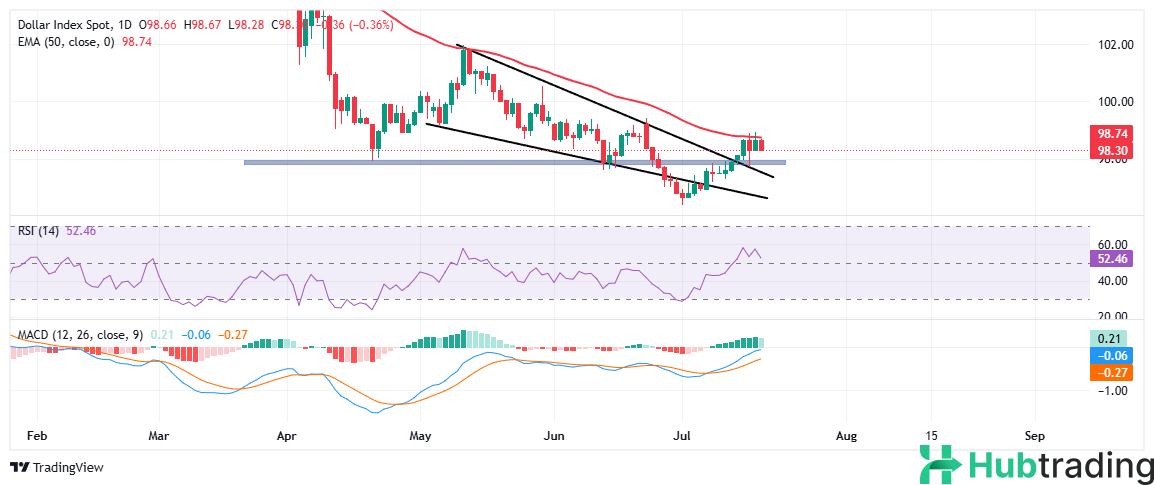-
The US Dollar retreats on Friday despite upbeat economic data and a strong labor market.
-
Declining US Treasury yields add to the downward pressure on the Greenback.
-
DXY shows waning momentum below the 50-day EMA after breaking out of a falling wedge pattern.
The US Dollar (USD) is easing lower on Friday, retreating from recent three-week highs as bullish momentum fades. Despite the pullback, the Greenback remains underpinned by a string of strong US economic data this week, which has diminished expectations for near-term interest rate cuts by the Federal Reserve (Fed).
The US Dollar Index (DXY), which measures the USD against a basket of major currencies, is down about 0.40%, trading around 98.23 in Friday’s US session after peaking near 99.00 on Thursday.
Fresh consumer sentiment data added to the week’s theme of economic resilience. The University of Michigan’s preliminary Consumer Sentiment Index for July climbed to 61.8, beating forecasts and suggesting growing confidence among US households. The report reinforced the Fed’s patient stance on rate cuts, though not enough to halt the Dollar’s intraday slide, as markets weigh broader concerns around yields, trade tensions, and central bank independence.
Other data this week has highlighted the economy’s strength: Retail Sales and Jobless Claims confirmed solid consumer activity and labor market stability, while the Philadelphia Fed Manufacturing Index delivered a positive surprise, jumping to 15.9 in July from -4.0 in June. On the inflation front, both CPI and PPI figures pointed to stubborn price pressures, keeping rate cut bets in check.
Meanwhile, ongoing trade uncertainties linked to US policy continue to cloud the outlook, supporting the Fed’s cautious approach and keeping the Dollar supported in the bigger picture.
Market Movers: Yields Fall, Trade Tensions Escalate, and Fed Uncertainty Grows
- US financial markets ended the week on a cautious note as Treasury yields declined, US-China trade frictions intensified, and diverging signals from Federal Reserve officials unsettled investor sentiment.
- The yield on the 10-year US Treasury note slipped to 4.44% on Friday, retreating from a five-week peak of 4.50% reached earlier in the week. The dip in yields added downward pressure on the US Dollar, which has already been losing steam after a recent rally.
- Tensions between Washington and Beijing flared again after the US Commerce Department imposed preliminary anti-dumping duties of 93.5% on Chinese graphite imports, citing unfair subsidies. Combined with existing tariffs, the total effective duty now stands at 160%, Bloomberg reported. The decision stems from a petition filed last December by US anode material producers targeting China’s dominance in key clean energy inputs. The aggressive move could prompt retaliatory actions from China, injecting further volatility into trade-sensitive assets and global supply chains.
- Markets were briefly shaken by rumors that former President Trump might remove Fed Chair Jerome Powell if reelected. While Trump later clarified it was “highly unlikely” he would fire Powell, the episode revived investor fears about political interference in central banking. Trump's ongoing criticism of the Fed for keeping rates "too high" and "slowing the economy" has added a layer of political risk to monetary policy outlooks.
- Fed officials, however, continue to emphasize data-driven decision-making. Yet conflicting statements from key policymakers have deepened market uncertainty.
- Fed Governor Christopher Waller reignited the debate on rate cuts by advocating a 25 basis-point reduction in July. He downplayed the inflationary impact of tariffs, arguing the Fed should shift policy toward a more neutral stance amid signs of weakening labor market momentum.
- In contrast, New York Fed President John Williams took a more cautious tone, warning that tariff-induced inflation is just beginning and could persist through 2026. Their diverging views illustrate the Fed’s internal divide as markets attempt to price in the path of interest rates.
- The latest Fed "dot plot" suggests two 25 bps rate cuts in the second half of 2025, lowering the benchmark rate to around 3.9% from the current 4.25%-4.50% range.
Technical Analysis: DXY Faces Resistance Near 50-Day EMA

The US Dollar Index (DXY) briefly broke out of a falling wedge pattern this week but ran into strong resistance near the 99.00 psychological level. The breakout stalled just below the 50-day Exponential Moving Average (EMA), currently around 98.74, halting further upside for now.
A confirmed daily close above this level could pave the way for a move toward the 99.50–100.00 range. On the downside, initial support is seen at 97.80–98.00, a former resistance area that could now act as a floor.
Momentum indicators suggest cautious optimism. The Relative Strength Index (RSI) remains above the neutral 50 level, around 53, indicating mild bullish control. The MACD is still in positive territory, but both indicators are showing signs of weakening momentum. This suggests that consolidation or a temporary pullback may occur before the DXY makes its next decisive move.





